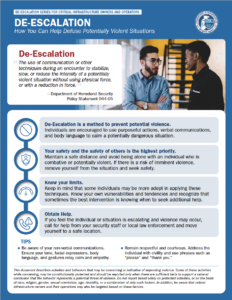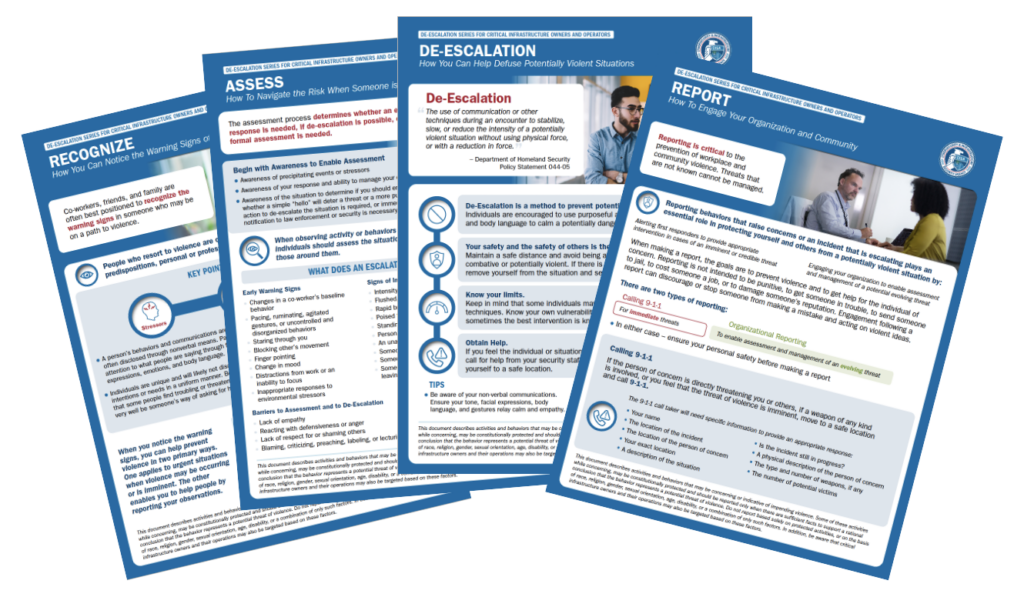Our team at Gate 15 appreciates the valuable alerts, guidance and products developed and shared by our government partners, at the U.S. federal level, our State, Local, Tribal, and Territorial (SLTT) partners, and our appreciated international partners. Many of those resources can be referenced on our Resources pages. Among our U.S. federal partners, the Cybersecurity and Infrastructure Security Agency (CISA) is a great partner and CISA’s built a series of publications providing guidance for security leaders and staff.
Earlier this week, CISA released their latest publication, the De-Escalation Series for Critical Infrastructure Owners and Operators, which was developed as a four-product series to help critical infrastructure owners, operators, and employees:
- Recognize the warning signs of someone on a path to violence;
- Assess if the situation or person of concern is escalating, or if an emergency response is needed immediately;
- De-escalate the situation currently taking place through purposeful actions, verbal communication, and body language; and
- Report the situation through organizational reporting to enable assessment and management of an evolving threat, and 9-1-1 for immediate threats.
The De-Escalation Series follows the Employee Vigilance Through the Power of Hello to help critical infrastructure owners, operators, and staff identify and navigate suspicious activity or potentially escalating situations to safely dis-engage and report to local law enforcement or their organization’s multi-disciplinary threat management team.
In the four products listed above, CISA notes that the use of communication or other techniques during an encounter to stabilize, slow, or reduce the intensity of a potentially violent situation without using physical force, or with a reduction in force. There are currently several hot-button issues around the world that can trigger or escalate situations very quickly. As such, it is important to be mindful of the four key elements. Some of the highlights of these products include:

Recognize. Co-workers, friends, and family are often best positioned to recognize the warning signs in someone who may be on a path to violence. People who resort to violence are often driven by a combination of predispositions, personal or professional stressors, and assorted resentments. Three critical elements of recognition stressors, changes in an individual’s behaviors, and behavioral indicators, all of which have been discussed in previous FB-ISAO reporting, especially as it pertained to the Hostile Events Attack Cycle or other incidents.
Assess. CISA looks at “How To Navigate the Risk When Someone is Escalating” which is a process that determines whether an emergency response is needed, if de-escalation is possible, or if a more formal assessment is needed. In these instances it is important that employees begin with awareness to enable the assessment.
- Awareness of precipitating events or stressors
- Awareness of your response and ability to manage your emotions
- Awareness of the situation to determine if you should engage, whether a simple “hello” will deter a threat or a more purposeful action to de-escalate the situation is required, or immediate notification to law enforcement or security is necessary.

De-Escalation is one method to prevent potential violence and has been incorporated into previous FB-ISAO reporting. CISA further advises that “individuals are encouraged to use purposeful actions, verbal communications, and body language to calm a potentially dangerous situation.”
- Your safety and the safety of others is the highest priority. Maintain a safe distance and avoid being alone with an individual who is combative or potentially violent. If there is a risk of imminent violence, remove yourself from the situation and seek safety.
- Know your limits. Keep in mind that some individuals may be more adept in applying these techniques. Know your own vulnerabilities and tendencies and recognize that sometimes the best intervention is knowing when to seek additional help.
- Obtain Help. If you feel the individual or situation is escalating and violence may occur, call for help from your security staff or local law enforcement and move yourself to a safe location.
Additional Tips Include:
- Be aware of your non-verbal communications. Ensure your tone, facial expressions, body language, and gestures relay calm and empathy.
- Remain respectful and courteous. Address the individual with civility and use phrases such as “please” and “thank you.”
Report. Reporting behaviors that raise concerns or an incident that is escalating plays an essential role in protecting yourself and others from a potentially violent situation by:
- Alerting first responders to provide appropriate intervention in cases of an imminent or credible threat
- Engaging your organization to enable assessment and management of a potential evolving threat

The product also provides tips on what to report as well. Overall, it is important to remember that when making a report, the goals are to prevent violence and to get help for the individual of concern. Reporting is not intended to be punitive, to get someone in trouble, to send someone to jail, to cost someone a job, or to damage someone’s reputation. Engagement following a report can discourage or stop someone from making a mistake and acting on violent ideas.
A full breakdown of each of the products can be found at the CISA website here.
